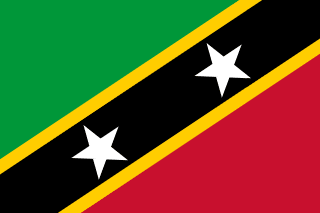Saint Kitts and Nevis - Geography

Here, let us take a look at the Geography of Saint Kitts and Nevis. Smallest country in the Western Hemisphere in terms of both area and population; the two volcanic islands are separated by a 3-km-wide (9-mi-wide) channel called The Narrows; on the southern tip of baseball-bat-shaped Saint Kitts lies the Great Salt Pond; Nevis Peak sits in the center of its ball-shaped namesake island. Mother's mean age at first birth is (), whereas, the Maternal mortality ratio is 74 deaths/100,000 live births (2023 est.)
Geographical data of Saint Kitts and Nevis
| Location | Caribbean, islands in the Caribbean Sea, about one-third of the way from Puerto Rico to Trinidad and Tobago |
|---|---|
| Geographic coordinates | 17 20 N, 62 45 W |
| Map references | Central America and the Caribbean |
| Tarrain | volcanic with mountainous interiors |
| Natural Resources | arable land |
| Natural Hazards | hurricanes (July to October) volcanism: Mount Liamuiga (1,156 m) on Saint Kitts and Nevis Peak (985 m) on Nevis are part of the volcanic-island arc of the Lesser Antilles, which extends from Saba in the north to Grenada in the south |
| Irrigated Land | 8 sq km (2012) |
| Major rivers (by length in km) | |
| Major aquifers | |
| Land Boundaries | 0 km |
| Border Countries | |
| Coastline | 135 km |
| Climate | tropical, tempered by constant sea breezes; little seasonal temperature variation; rainy season (May to November) |
| Area | |
| Total Area | |
| Land Area | 261 sq km |
| Water Area | 0 sq km |
| comparative Area | 1.5 times the size of Washington, D.C. |
| Maritime Claims | |
| Territorial sea | 12 nm |
| Contiguous zone | 24 nm |
| Exclusive economic zone | 200 nm |
| Continental shelf | 200 nm or to the edge of the continental margin |
| Elevations | |
| Highest point | Mount Liamuiga 1,156 m |
| Lowest point | Caribbean Sea 0 m |
| Land Use | |
| Agricultural land | 23.1% (2022 est.) |
| Agricultural land: arable land | arable land: 19.2% (2022 est.) |
| Agricultural land: permanent crops | permanent crops: 0.4% (2022 est.) |
| Agricultural land: permanent pasture | permanent pasture: 3.5% (2022 est.) |
| Forest | 42.3% (2022 est.) |
| Other | 34.6% (2022 est.) |
Population Distribution
Population clusters are found in the small towns located on the periphery of both islands
People and Society
In Saint Kitts and Nevis, the different Ethnic groups are such that we have: African descent 92.5%, mixed 3%, White 2.1%, East Indian 1.5%, other 0.6%, unspecified 0.3% (2001 est.)
| Population | |
|---|---|
| Pop growth rate | 0.56% (2024 est.) |
| Birth rate | 11.8 births/1,000 population (2024 est.) |
| Death rate | 7.4 deaths/1,000 population (2024 est.) |
| Health expenditure | |
| Physicians Density | |
| Hospital bed Density | 4.3 beds/1,000 population (2021 est.) |
| Total fertility rate | 1.76 children born/woman (2024 est.) |
| Gross reproduction rate | 0.87 (2024 est.) |
| Contraceptive prevalence rate | NA |
| Est married women (ages 15-49) | 57.2% (2023 est.) |
| Literacy | |
| Education expenditures | |
| Net Migration rate | 1.1 migrant(s)/1,000 population (2024 est.) |
| Nationality | Kittitian, Nevisian | Kittitian(s), Nevisian(s) |
| Languages | English (official) |
| Religions | Protestant 75.6% (includes Anglican 16.6%, Methodist 15.8%, Pentecostal 10.8%, Church of God 7.4%, Baptist 5.4%, Seventh Day Adventist 5.4%, Wesleyan Holiness 5.3%, Moravian 4.8%, Evangelical 2.1%, Brethren 1.7%, Presbyterian 0.3%), Roman Catholic 5.9%, Hindu 1.8%, Jehovah's Witness 1.4%, Rastafarian 1.3%, other 5%, none 8.8%, unspecified 0.1% (2011 est.) |
| Age Structure | |
| 0-14 years | 19.2% (male 5,314/female 5,277) |
| 15-64 years | 68.1% (male 18,944/female 18,575) |
| 65 years and over | 12.7% (2024 est.) (male 3,341/female 3,682) |
| Dependency Ratios | |
| Total dependency ratio | 46.9 (2024 est.) |
| Youth dependency ratio | 28.2 (2024 est.) |
| Elderly dependency ratio | 18.7 (2024 est.) |
| Potential support ratio | 5.3 (2024 est.) |
| Median Age | |
| Total | 38.6 years (2024 est.) |
| Male | 38.8 years |
| Female | 38.3 years |
| Urbanization | |
| Urban population | 31.1% of total population (2023) |
| Rate of urbanization | 1.06% annual rate of change (2020-25 est.) |
| Major urban areas (Pop) | 14,000 BASSETERRE (capital) (2018). |
| Sex Ratio | |
| At birth | 1.02 male(s)/female |
| 0-14 years | 1.01 male(s)/female |
| 15-64 years | 1.02 male(s)/female |
| 65 years and over | 0.91 male(s)/female |
| Total population | 1 male(s)/female (2024 est.) |
| Infant Motality | |
| Total | 8 deaths/1,000 live births (2024 est.) |
| Male | 5.5 deaths/1,000 live births |
| Female | 10.6 deaths/1,000 live births |
| Life Expectancy at birth | |
| Total population | 77.6 years (2024 est.) |
| Male | 75.2 years |
| Female | 80.1 years |
| Drinking Water Sources | |
| Improved: urban | urban: 98.3% of population |
| Improved: rural | rural: 98.3% of population |
| Improved: total | total: 98.3% of population |
| Unimproved: urban | urban: 1.7% of population |
| Unimproved: rural | rural: 1.7% of population |
| Unimproved: total | total: 1.7% of population (2015 est.) |
| Sanitation facility acess | |
| Improved: urban | urban: 87.3% of population |
| Improved: rural | rural: 87.3% of population |
| Improved: total | total: 87.3% of population |
| Unimproved: urban | urban: 12.7% of population |
| Unimproved: rural | rural: 12.7% of population |
| Unimproved: total | total: 12.7% of population (2017 est.) |
| Alcohol consumption per capita | |
| Total | 8.84 liters of pure alcohol (2019 est.) |
| Beer | 3.73 liters of pure alcohol (2019 est.) |
| Wine | 1.02 liters of pure alcohol (2019 est.) |
| Spirits | 3.89 liters of pure alcohol (2019 est.) |
| Other alcohols | 0.21 liters of pure alcohol (2019 est.) |
Demographic profile
All Important Facts about Saint Kitts and Nevis
Want to know more about Saint Kitts and Nevis? Check all different factbooks for Saint Kitts and Nevis below.
-
 Saint Kitts and Nevis Factbook
Saint Kitts and Nevis Factbook
-
 The Economy of Saint Kitts and Nevis
The Economy of Saint Kitts and Nevis
-
 Learn about the Government of Saint Kitts and Nevis
Learn about the Government of Saint Kitts and Nevis
-
 Communication in Saint Kitts and Nevis
Communication in Saint Kitts and Nevis
-
 Popular Universities in Saint Kitts and Nevis
Popular Universities in Saint Kitts and Nevis
-
 Enerny in Saint Kitts and Nevis
Enerny in Saint Kitts and Nevis
-
 Transport in Saint Kitts and Nevis
Transport in Saint Kitts and Nevis
-
 The Geography and society of Saint Kitts and Nevis
The Geography and society of Saint Kitts and Nevis
-
 The Environment of Saint Kitts and Nevis
The Environment of Saint Kitts and Nevis
-
 Military and security in Saint Kitts and Nevis
Military and security in Saint Kitts and Nevis